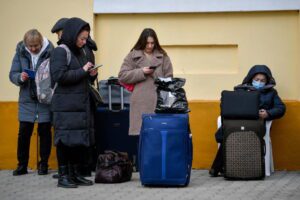
The L-70 anti-aircraft guns were sent from Lithuania to Ukraine on Friday, LRT reported.
“They will be able to destroy enemy planes, helicopters and UAVs at a distance of up to 5 kilometers in any weather conditions,” the report says.
It is noted that in addition to the anti-aircraft guns, ammunition and other equipment necessary for the operation of these units will also be transferred to Ukraine in the near future.

Ukrainian agrarians have applied to the authorities of the Republic of Poland with a request to lay a broad-gauge railway line (with a gauge of 1520 mm) across its territory, which will connect the port of Polish Gdansk with the Ukrainian and Lithuanian railway networks to export agricultural products and ensure strategically important imports through western borders of Ukraine.
The corresponding appeal to the President of the Republic of Poland Andrzej Duda and its Prime Minister Mateusz Morawiecki was sent by the leading Ukrainian agrarian associations: the All-Ukrainian Agrarian Council (VAR), the Agrarian Union of Ukraine, the Ukrainian Agrarian Business Club, the All-Ukrainian Association of Communities, the Union of Poultry Breeders of Ukraine and the Ukrainian Agrarian Confederation, reportedly on the VAR website on Friday.
According to the appeal, one of the largest and closest European ports to Ukraine is the port of Klaipeda (Lithuania), which has significant free transshipment capacities. However, due to differences in the gauge between Poland, Ukraine and the Baltic countries, there is a need to reload the contents of wagons at border crossings between countries or rearrange wagon bogies, which does not allow to fully realize the export-import potential of the port of Klaipeda.
In turn, the use of vehicles or containers as an alternative to railway transportation is poorly suited for transporting bulk bulk cargo (coal, ore, grain, metal) over long distances and increases their cost to an uncompetitive level. In addition, in the case of using container terminals, the capacity of the railway line will be limited by their capacity, which will also prevent full use of the potential.
“In our opinion, the laying of a railway line with a gauge of 1520 mm across the territory of the Republic of Poland, which will connect the Ukrainian and Lithuanian railway networks, as well as connect the port of Gdansk to them for the transport of goods and passengers, will solve the above-mentioned problems,” the appeal of the Ukrainian farmers.
At the same time, it is emphasized that such a logistical path will give significant positive financial and economic effects for Poland and Ukraine, not only due to an increase in export-import capacities, but also due to the unification of the economic space of Poland, the Baltic countries and Ukraine.
Such a project can be implemented through the reconstruction of the existing railway network and the construction of a combined track, or the construction of a separate railway branch.
As reported, in June 2022, Polish Deputy Prime Minister Yaroslav Kaczynski said that the issue of building this broad-gauge railway track had already been tentatively approved by the Polish and Ukrainian governments.
In early June, the VAR already proposed to build 300 km of broad-gauge railway tracks in Poland for direct grain deliveries to the Lithuanian port of Klaipeda, which would allow not to overload the contents of wagons at the Ukraine-Poland and Poland-Lithuania border crossings due to the difference in railway gauge in these countries.

Lithuania has resided more than 50,000 Ukrainians who were forced to leave the country due to Russia’s war against Ukraine, a third of them have already been employed, Ukrainian Ambassador to Lithuania Petro Beshta has said.
“Lithuania received Ukrainian citizens, now temporarily displaced persons, in an amount that corresponds to 1.8% of the total population. This is a very large figure for a state like Lithuania, but they continue to accept Ukrainians and provide everything necessary. More than 50,000” Beshta said at a briefing at the Ukraine Media Center on Thursday.
He specified that the total population of Lithuania is 2.7 million people.
According to Beshta, a third of Ukrainians who arrived in Lithuania have already been employed.
“As of now, one third of the adult population of Ukrainians who can work has already been employed. They receive an average salary of about EUR 900. Another third are looking for this job. And the other third, probably, has not yet decided, because there is also a psychological barrier for Ukrainians, and everyone is talking about it – Lithuanians and Ukrainians: that our people are not always ready to look at their stay in Lithuania so long-term, to look for work, because each of us, we all believe that the war will end quickly and they will return home soon,” he said.
The ambassador also noted that 500 Ukrainians in Lithuania have already told the authorities about their plans to return to Ukraine.
“We cannot accurately verify whether they returned and in what condition, but this trend is already emerging,” Beshta stressed.

Lithuania is ready to help Ukraine export unsold volumes of grain from last year’s harvest, Lithuanian Minister of Communications and Transport Marius Skuodis told reporters.
According to him, grain can be transported through Poland to the port of Klaipeda. Companies have already submitted proposals.
“We have been working with the Ukrainians for several weeks now, the most important thing is coordination with the railways. Several companies have already received specific proposals for transportation from the Ukrainian-Polish border to the port of Klaipeda,” Skuodis said.
At the same time, he noted that the main problem lies in the different width of the railway track of the Russian and European types.
“It is rather difficult to switch from Russian standard tracks to European ones in Poland, then to the Kaunas intermodal terminal and beyond. These are issues related to the availability of wagons and other things,” Skuodis said.
According to him, a trial train is already planned, which should leave in the coming weeks.
“The trial run is scheduled for April. We are ready for our part, we just need customers, and we can try in late April – early May, then we’ll see. Of course, the most direct route will be through Belarus, but this country is involved in certain military operations, therefore it would be impossible,” Skuodis said.
Grain export from Ukraine was disrupted due to Russia’s military actions on Ukrainian territory.
According to the head of the European Commission in Lithuania, Marius Vashchega, Ukraine occupies 10% of the world wheat market, 13% – barley, 15% – corn, more than 50% of the sunflower oil market.

President of Ukraine Volodymyr Zelensky held a meeting in Kyiv with President of Poland Andrzej Duda, President of Latvia Egils Levits, President of Lithuania Gitanas Nauseda and President of Estonia Alar Karis, who are visiting Ukraine.
“The heads of state held a meeting in the format of a working lunch,” the press service of the President of Ukraine reports.
After the talks are over, the presidents will talk to media representatives.

Nearly 43,800 refugees from Ukraine have been registered in Lithuania, 18,200 of them are minors, data from the Lithuanian Statistics Department released on Tuesday show.
Over the past 24 hours, 857 refugees have been registered in Lithuania, of which 334 are minors, including 87 children under six years of age. The weekly average daily rate of arrivals from Ukraine, according to the latest data, is 489 people.
Approximately a third of the Ukrainians who arrived were registered at the Vilnius registration center, about 6,000 – at the Kaunas center. Almost 4,900 refugees who arrived in Lithuania are children under the age of six, 13,400 are between the ages of 6 and 18. More than 1.9 thousand are people over the age of 65.
Most of the arrivals applied for a temporary residence permit for humanitarian reasons. Most of the arrivals are women and children.